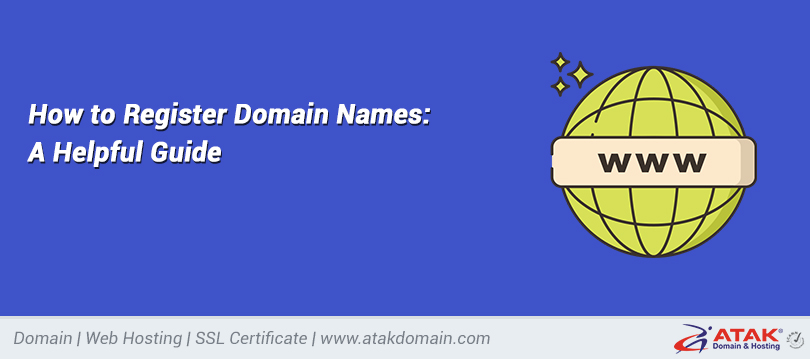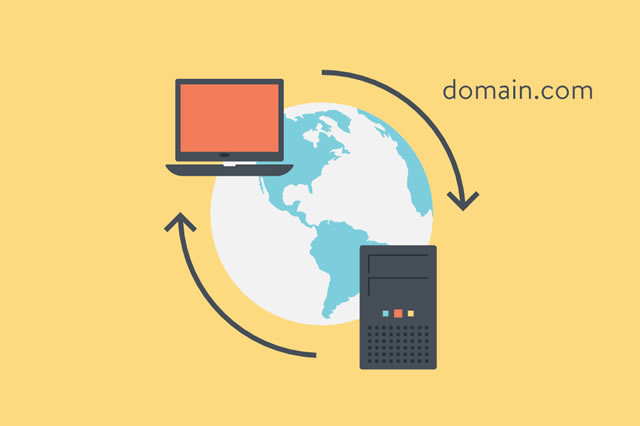

What is the top level domain?
TLD is the abbreviation for Top Level Domain. So, what is Top Level Domain as a generic term? Basically, it is the most important hierarchical part of a domain name. This is all about the organisation of web addresses in the Internet globally. Generic Top Level Domains or gTLDs indicate particular groups of domain names in other words. Consider the example “atakdomain.com”; in which the last part is “com”, and it is called as gTLD of this domain name.
What about the other parts of a Domain Name?
Of course, any domain name consists of multiple parts (at least two parts) separated by “dot” (i.e., “.”). In addition to a TLD, the other component of a domain name is Second Level Domain (SLD) just left to the TLD. It is also called as subdomain and used to distinct one website from the others under the same TLD. Consider again the example “atakdomain.com”; in which the first part is “atakdomain”, and it is called as SLD of this domain name.
How to choose the best TLD for your brand or business
In order to start up a new business with globally thinking, after a cracking brain storm you have to get the best TLD and domain name that best fit your needs. This will ensure your website accessed and utilised widely. Always keep in mind that your website will in the future be a key to success. Therefore, both the TLD and/or ccTLD choices should be made cleverly in addition to the subdomain name indicating your business elegantly. Name of the TLD or earnest use of ccTLD is highly of importance as the starting point for creative thinking to build a successful business or brand. For example, if you would like to have a company operating internationally then it is best to prefer “com” (e.g., “atakdomain.com”) while nationwide or a specific regional focus of a business can be better utilized through a ccTLD (e.g., “holidays.com.es”).
TLD types: gTLD, ccTLD, sTLD and iTLD
TLDs are mainly categorized in four groups by the Internet Corporation for Assigned Names and Numbers (ICANN):
- Generic Top Level Domains (gTLD) are the most familiar TLDs such as “com” for commercial, “net” for network, “edu” for education and “gov” for government. Although these are available for anyone, there are a few strictly controlled subgroups. There are 21 gTLDs well-known and usually at least three characters.
- Country Code Top Level Domains (ccTLD) are designed to indicate a particular geographic location or country. There are over 200 ccTLDs indicated with two letters. They are likely to offer big advantages for specialized businesses around the world as targeting a well-defined group of Internet explorers. Among them the most popular ccTLDs are “cn” for China, “tk” for Tokelau, “de” for Germany, “uk” for United Kingdom and “ru” for Russia.
- Sponsored Top Level Domains (sTLD) are administered by private organizations and industry. Here are the most known: “aero”, “cat”, “coop”, “int”, “jobs”, “mil”, “mobi”, “tel” and “travel”.
- Infrastructure Top Level Domain (iTLD) is namely Address and Routing Parameter Area (ARPA) and “arpa” TLD is managed just for The Internet Engineering Task Force (IETF) body defining standard Internet operating protocols.
Historical view for IP addresses, website addresses and Domain Name organization?
Bearing in mind the ever-increasing number of the websites, it was a decisive task to organize web addresses. From 1 website in 1991 (i.e., World Wide Web Project), nowadays over 1.94 billion websites are on the Internet. However, a recent survey stated that just about 200 million of them are active indeed. Since 1983, the Domain Name System (DNS) has been in use to simplify and indicate websites by means of domain names rather than IP (Internet Protocol) addresses. It is used to translate a long number IP address (for example, 185.46.41.121) into a specific domain name (for example, atakdomain.com) that is rather easy to remember and practical to use in daily life, compared to the corresponding IP address.
How do I get TLD, gTLD and buy Domain Name?
ICANN is the standard registration body for domain names and Top Level Domains - gTLDs. Globally, it has several accredited online registrars. atakdomain.com is well one of them enabling domain name searches to readily meet your business needs with its active supporting team and infrastructure. After finding the perfect domain name and meeting your business desires, you can very easily register your domain name at low costs and get also highly reliable and unfailing web hosting offers. Usually, gTLDs may cost between $9.99 and $2.99 to register for a year. If you want you can also register it for 5 years. You can visit a domain name registrar web site and have look at the Top Level Domain list of prices at https://www.atakdomain.com/en and quickly buy a domain name that you like, where here are some popular extensions and their prices:
- com $9,99 /Year
- net $11,99 /Year
- org $11,99 /Year
- info $2,99 /Year
How many TLDs are there?
The number of TLDs have been steadily increasing just above 1,528 for website addresses (as of August 2019). They cover amazingly everything from “aaa” to “zw”. So which TLD is the most preferred considering the global use, business effect and other measures? Studies for website popularity to rank the first 1 million showed also that more than 48% of them are “com” domains among the 2142 different ones.
Which TLD is the most preferred?
Highly depending on the TLD, generic or specific searches especially with Google in the Internet result in displaying a mostly related websites list including your company’s name, address and commercial business. For being on top of the search lists, you may consider the “com”, ”net”, “org” and “co” gTLDs for the sake of awareness and accessibility. The most registered domain extension in the world is still and far ahead “com”, well above 137 million in 2018.
 Running a successful business today requires building a successful online presence that expands your business beyond a brick and mortar store.
Running a successful business today requires building a successful online presence that expands your business beyond a brick and mortar store.
More and more shoppers are looking online for all of their needs, and if your business doesn't exist, you might lose profits and repeat customers. Just registering a domain name does not guarantee success. Instead, it's helpful to understand website domain names, how they work, the different types of domain names available, and how this technology plays a role in your decision to choose the ideal domain name.
Let's start with the question, "What is a top-level domain?"
Online success starts with great scope; Get yours today on Atakdomain.com.
The early days of computers
To understand Top Level Domains (TLDs), you first need to know how domains work with IP addresses. Think of it this way: every device that connects to the web has an IP address, or a unique electronic signature, that distinguishes one device from another. The domain name is the specified text entered after the protocol tag (http: //) for the web address. For example, at http://google.com/search/, the domain name is "Google."
Although you are probably familiar with more prominent domain names, not many are aware that these names denote a website's IP address. In fact, every device that connects to the web has an IP signature. When computers were first created, computer scientists invented an ingenious way to communicate using digital strings of 32 or 128 bits, known as Internet Protocol (IP) addresses. These IP addresses served two purposes:
- Determine the network or host.
- The location of the computer terminal.
Computers are programmed to follow these sets of protocols in order to locate and communicate with another computer, or to communicate with the web. These protocols facilitate this communication, making it easier for computers to find each other, and to send or request information.
DNS
In the early days, this numerical system was in effect, since there were so few computers on the network. However, as you might imagine, keeping track of which IP address a computer went to became more difficult as more computers and systems were added. Organizing and managing IP addresses was not a feasible or effective method, as you had to know the exact IP address of any desired website or computer. To simplify this complex system, computer scientists have created the Domain Name System (DNS).
While computers work great with numbers, humans tend to prefer words. We are infinitely better at remembering and categorizing names, unlike seemingly random number sequences. Knowing this, the Domain Name System has been proposed as a remedy for the IP address dilemma. This system allows the IP address owner to associate this numeric string with a unique domain name. So, instead of having to remember “74.125.224.72”, you can simply type in Google.com.
This system was met with resounding enthusiasm. In one fell swoop, the following improved:
Make the system easier to navigate.
- Help distinguish, organize, track, and monitor IP addresses.
- Increasing the ability to surf and use the Internet.
As a result, in less than three decades, the DNS database has added billions of names.
How does DNS work:
 The DNS database lists all of the domain names and their corresponding IP addresses. Anytime the domain name is entered, the DNS forwards this domain name via the DNS server. This server is not one mega server, but rather a sea of servers all over the world, which work in harmony to distinguish one IP address from another.
The DNS database lists all of the domain names and their corresponding IP addresses. Anytime the domain name is entered, the DNS forwards this domain name via the DNS server. This server is not one mega server, but rather a sea of servers all over the world, which work in harmony to distinguish one IP address from another.
When a search occurs, filtering is done by the following:
- Duplicate DNS
- Root Name Server
Top-level domain name server
Official Name Server
When this happens, there is a system hierarchy and protocol arrangement that facilitates searching through the servers. A top-level domain (TLD) is the highest level in this hierarchical domain name system.
Original top-level domains
- In essence, a TLD, also known as a domain extension, is what follows the domain name in the query. .Com at google.com is the top-level domain. These extensions have been suggested as ways to help further differentiate and categorize domains. In the early days of the Internet, the system was classified more strictly according to these TLDs.
- The top-level domain is designed to help categorize a website feature, such as purpose, owner, or geographic origin. It has also doubled the number of domain names available, because cars.com isn't the same as cars.org. For this purpose, six original top-level domain names were created. Now that you understand what domain name extensions are, and know how they work, here are some of the most popular options available:
- .Com - dot-coms for business, is the most popular top-level domain (TLD) in use today. As their names suggest, it was initially intended to distinguish commercial organizations. The first three .com files were:
- Symbolics.com
- BBN.com
- Thnk.com
In the early days, .com was restricted to commercial entities, but by the 1990s, these restrictions were lifted, leading to the opening of registration doors. As the Internet continues to grow in use and popularity, dot-coms quickly become the most used top-level domain.
- .net - short for network, point networks are created for network technology companies such as infrastructure companies or Internet Service Providers (ISPs). When it was first introduced, only one domain used dot-net TLD, Nordu.net, which connected national research and educational networks in the Nordic countries. Similar to .coms, the restrictions on .net were not strictly enforced, eventually resulting in it becoming a "general purpose namespace".
- .edu - As you likely know, .edu is a top-level domain intended for US educational institutions, such as colleges or high schools. The top three are:
University of California Berkeley - Berkeley.edu
Carnegie Mellon University - Cmu.edu
Purdue University - Purdue.edu
Unlike dot-nets or dot-coms, dot-edu TLD restrictions are strictly supported, which means it must be an accredited and registered educational body. While they used to be only four-year post-secondary institutions, they are now limited to accredited U.S. post-secondary educational institutions. - .org - originally created for organizations that operated as nonprofits, the first being the Miter Corporation at Miter.org. This has also become a generic TLD that is used by both nonprofits and profit organizations.
- .mil - Created and used by the US military. Dot-mils are high-level domain extensions limited to the United States military branches:
- United States Army
- United States Navy
- US Marine Corps
- United States Air Force
- United States Coast Guard
-
As a note, countries outside of America that want to use .mil must first use their country code to distinguish them from the US military branches.
- .gov - short for government, dot-govs, similar to dot-mils, are limited to US federal government agencies and personal use. Dot-govs are used by federal government agencies, programs, cities, states, counties, and towns.
Country code top-level domains
Although the Internet was created for US government use, it quickly opened up to the public, as well as to the rest of the world. Since many of these top-level domains were limited to the U.S. government or the U.S. military, country code top-level domains (ccTLDs) were added to help distinguish one country from another. The two-letter country codes are:
- .au – Australia
- .ca – Canada
- .mx – Mexico
- .uk – Great Britain
Generic top-level domain
Over time, more top-level domains were added to the original list. Presently, there are 21 generic top-level domains at the peak of the domain name system hierarchy. These 21 generic TLDs can be split into four categories:
Generic – Domains that are used for general reasons.
- .com
- .info
- .net
- .org
Generic restricted – Domains that must be used for their intended purposes
- .biz
- .name
- .pro
Infrastructure – Meant solely for aiding the DNS infrastructure. The only TLD within this subcategory is .arpa.
Sponsored domains – These can only be utilized by companies or entities tied to these industries including:
- .aero
- .asia
- .cat
- .coop
- .edu
- .gov
- .int
- .jobs
- .mil
- .mobi
- .tel
- .travel
- .xxx
Generic TLDs
 Today, there are more than 1,500 generic extensions available for purchase and worthy of consideration. While your first inclination may be to try and use a .com, such a TLD can sometimes be costly, and many of the domain names linked to that TLD are already taken. The market is oversaturated with millions upon millions of websites. Finding a domain name with a popular TLD that is relevant and helpful to your business can be quite difficult.
Today, there are more than 1,500 generic extensions available for purchase and worthy of consideration. While your first inclination may be to try and use a .com, such a TLD can sometimes be costly, and many of the domain names linked to that TLD are already taken. The market is oversaturated with millions upon millions of websites. Finding a domain name with a popular TLD that is relevant and helpful to your business can be quite difficult.
Because of this, it may be wise to consider purchasing a newer generic TLD. Benefits of this include:
- Availability – New domain extensions allow you the opportunity to use your company’s name, or use a word or phrase linked to your industry that would have been taken decades ago with the original TLDs.
- Cost – If a popular domain name is available, it may cost a lot of money. That same name with a generic TLD extension can cost considerably less money.
- Creative Names – New domain extensions allow you to be creative with your domain naming process. The domain name can be combined with the generic extension to create a full name, or a clever play on words, that helps the target audience remember the name.
- Rank on SERPs – Google’s search algorithm has been updated so that domains that do not use a main TLD are not ranked lower for that reason. You don’t need to worry about your rankings on Search Engine Results Pages (SERPs) being affected by this newer gTLD.
Registering a top-level domain
In order to register a domain name with the Internet Corporation for Assigned Names and Numbers (ICANN), you must do so with a registrar, such as Atakdomain.com. You can check if the ideal domain name and domain extension are available by searching on the domain. You will need to provide the following information when registering:
- Your domain name
- Extending your top-level domain
Your contact information: first name, last name, email address, phone number, and physical address
- Your billing information
After receiving this information, Atakdomain.com sends this information to ICANN and the DNS. Once confirmed, you can quickly set up your domain and create a website.
Top-level domains help customers find your business online
The creation of the DNS opened the Internet to the world, increasing its accessibility and ease of use. Top-level domains have helped simplify and further categorize the different domain names, and the newer generic TLDs have increased the number of possible domains. As a result, you can rest assured that the perfect domain and range of top-level domains are here, just waiting for you.
Categories
- Domain Guide & Registration Process
- Email Services & Setup Instructions
- Step-by-Step How-To Guides
- Insights & Articles from the Tech World
- Server Management & Performance Tips
- Software Development & Coding Resources
- SSL Certificate Guide for Secure Websites
- Choosing the Best Hosting & Optimization Tips
- Key IT Terms & Their Definitions
- SQL Database Management & Queries
- WordPress Setup & Optimization Strategies







